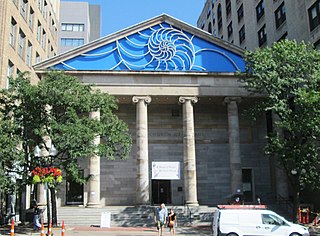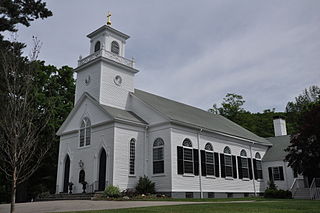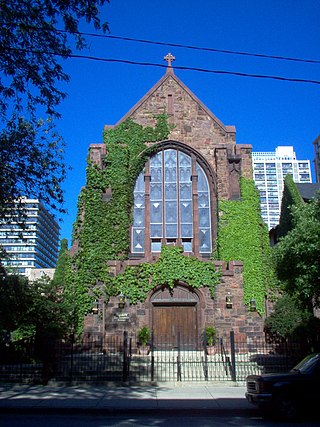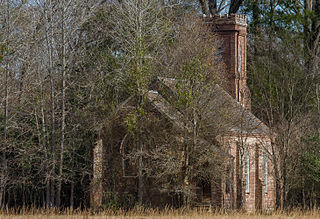
The Cathedral Church of St. Paul, Boston is the historic cathedral church of the Episcopal Diocese of Massachusetts. Located at 138 Tremont Street near Downtown Crossing, directly across from Boston Common and Park Street Station, the cathedral is adjacent to the diocesan offices. On April 22, 2018, Amy E McCreath was named the ninth dean and first female dean of the Cathedral Church of St. Paul, and was installed as dean on September 29, 2018. The church, designed by Alexander Parris and Solomon Willard and built in 1819, was the first Greek Revival church in New England, and was designated a National Historic Landmark in 1970 for its architectural significance.

St. Stephen's Episcopal Church is a historic parish of the Episcopal Diocese of Pennsylvania, founded in 1823 in Philadelphia, Pennsylvania and located at 19 South Tenth Street, on the corner of Tenth Street and Ludlow Street. St. Stephen's was designed by William Strickland in the Gothic revival style. It is the oldest extant building in Philadelphia in this style and was designed by an architect-engineer best known for Greek Revival buildings, though, like his mentor Benjamin Latrobe, he produced buildings in other "picturesque" styles as well. St. Stephen's first service was held on February 27, 1823. On June 4, 1979, it was added to the National Register of Historic Places. On May 28, 1957, it was designated a historic landmark by the Philadelphia Historical Commission.
Christ Episcopal Church may refer to the following similarly named churches or parishes in the United States:

Trinity Episcopal Church is located in Covington, Kentucky, Madison Avenue. This historic church was founded November 24, 1842, in a third floor of a brick building near the Covington market. The cornerstone of the first church was June 24, 1843 and the first service was on June 30, 1844. The church has served the people of Covington and Cincinnati, Ohio through wars and floods. The church is active today, with a large congregation at its Fourth and Madison Avenue location. The Rev. Peter D'Angio is the rector. It is the second largest parish in the Episcopal Diocese of Lexington.

St. Mary's Episcopal Church and Cemetery is a historic church and cemetery at 258 Concord Street, in the village of Newton Lower Falls, Massachusetts, United States. St. Mary's Parish was formed in 1811. The church, built in 1813–14 and restyled in 1838, is the oldest church in Newton, and is a fine example of Gothic Revival/Federal style architecture. The cemetery, which dates from 1812, is the oldest non-government-owned cemetery in Newton. The property was listed on the National Register of Historic Places in 1980.

The Church of the Incarnation built in 1896 is a historic Carpenter Gothic Episcopal church building located at 111 North 5th Street in Highlands, Macon County, North Carolina.

St. John the Baptist Church is a historic Episcopal church located at 118 High Street in the Sanbornville village of Wakefield, New Hampshire, in the United States. Built 1876–77, it is a prominent regional example of Carpenter Gothic architecture. It was listed on the National Register of Historic Places in 1984. Information about the church and leadership can be found on their website.

St. John's Episcopal Church is a historic Episcopal church located on the village green in the village of Highgate Falls in Highgate, Vermont, in the United States. Built 1829–30, it is prominent local example of a Federal style church with Gothic Revival features. On September 3, 1976, it was listed on the National Register of Historic Places.

All Saints Church is an historic Episcopal church located at 51 Concord Street in Peterborough, New Hampshire, in the United States. Completed in 1914, it is a completely realized example of an English country church as interpreted by the architect Ralph Adams Cram. On December 1, 1980, it was added to the National Register of Historic Places.

St. Andrew's Episcopal Church is a historic Episcopal church located at 2067 Fifth Avenue at 127th Street in the neighborhood of Harlem in Manhattan, New York City. Built in 1872, it was designed by noted New York City architect Henry M. Congdon (1834–1922) in the Gothic Revival style. It features a 125 foot tall clock tower surmounted by a slate covered spire surrounded by four towerlets.

Holy Trinity Episcopal Church also known as Holy Trinity Memorial Church is an historic Episcopal church building located at 38 Grand Avenue in the village of Swanton, Franklin County, Vermont. Built in 1876 and expanded in 1909-10, the church facilities include a fine example of the Carpenter Gothic in the older section, and the Late Victorian Gothic Revival in the newer section. The church was listed on the National Register of Historic Places as the Parish of the Holy Trinity in 2001. The church is an active parish in the Episcopal Diocese of Vermont; its current rector is the Rev. Reid D. Farrell.

St. Thomas Episcopal Church is a historic Episcopal church building located at 2720 Slaterville Road, east of the post office in Slaterville Springs in the town of Caroline, Tompkins County, New York. It was built in 1893 and is an example of the Carpenter Gothic style of architecture, sometimes called the High Victorian Gothic. It features include, a steeply sloped roof, lancet windows, lancet covered entry through a side steepled belfry, all of which are typical of the Carpenter Gothic style.

Trinity Episcopal Church is a parish church in the Episcopal Diocese of Iowa. The church is located in Iowa City, Iowa, United States. It was individually listed on the National Register of Historic Places in 1974. In 2021, the building was included as a contributing property in the Iowa City Downtown Historic District.

St. John Chrysostom Church, also known as the Episcopal Church of St. John Chrysostom and the Little Red Church on the Hill, is a wooden Episcopal church built in 1852 in Delafield, Waukesha County, Wisconsin. In 1972 it was listed on the National Register of Historic Places.

The Episcopal Church of the Atonement and Parish House is a historic church building at 5751 North Kenmore Avenue in Chicago, Illinois. The Gothic Revival building was constructed in 1889 and added to the National Register of Historic Places in 2009.

The Arcola Presbyterian Church is a historic Presbyterian church in Arcola, Louisiana, United States. It was built in 1859 and is of the Greek Revival architectural style. It is owned by the Amite–Arcola Presbyterian Church in Amite, Louisiana. The five-acre property was dedicated in 1859 by John Corkern and John Leonard to promote "Christianity, morality and education under the jurisdiction of the Conference of the Methodist Episcopal Church South."

The St. Mary's Episcopal Church in Franklin, Louisiana, United States, is a historic church at 805 1st Street. Designed by New Orleans architect James Freret for R.W. Micou, it was advertised by the Lhote Lumber Company in its 1883 Buyers' Guide.

Grace Memorial Episcopal Church is a historic church at 100 W. Church Street in Hammond, Louisiana, U.S.A.

St. John's Episcopal Church is a historic church on Old Laurel Hill Road in Laurel Hill, Louisiana. It is maintained as a chapel of Grace Church of West Feliciana Parish.

St. Mary's Episcopal Church is a historic church building in Weyanoke, Louisiana.





















